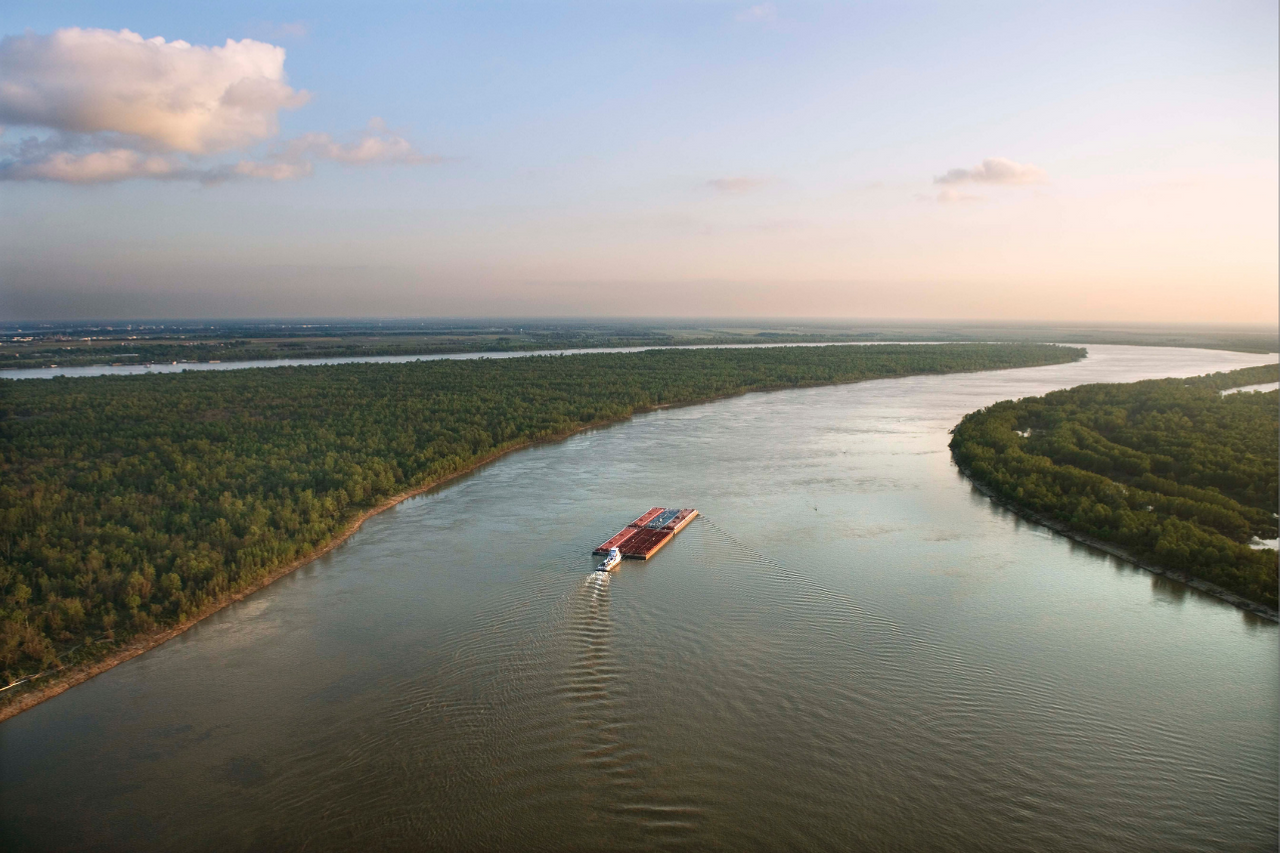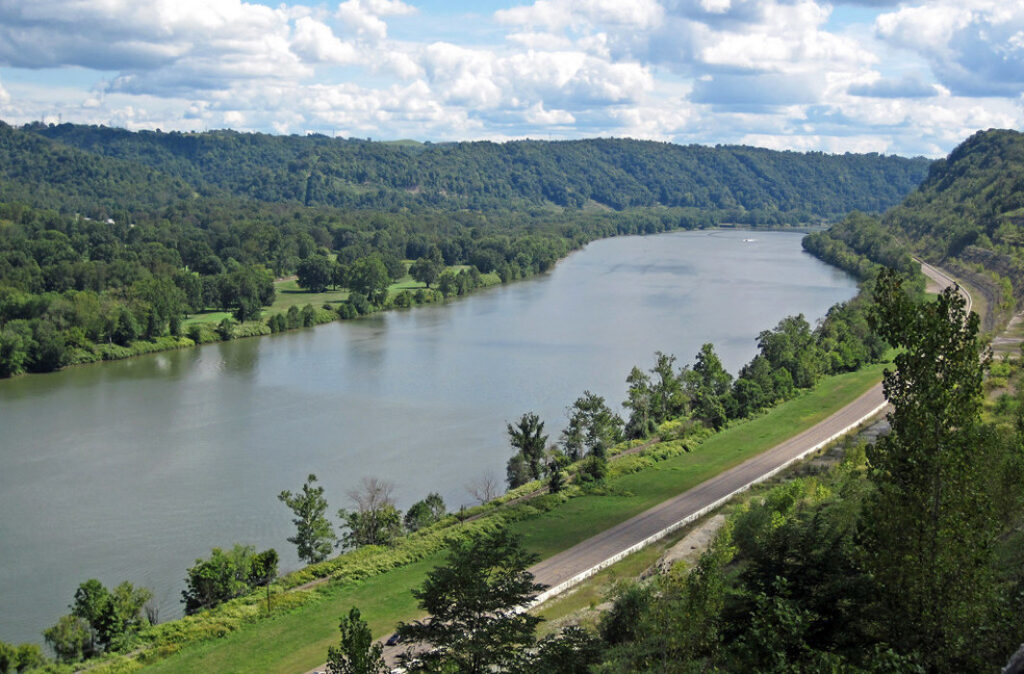Mississippi River
A Cultural Treasure

What more can be said about the mighty Mississippi River that hasn’t been said already? Plenty, apparently.
Even the river’s resident literary laureate, Mark Twain, noted how much of the 2,320-mile Mississippi’s finest landscape has been long overlooked as our collective gaze has been fixed upon the river below St. Louis. In 1886, he told the Chicago Tribune, “Along the Upper Mississippi every hour brings something new. There are crowds of odd islands, bluffs, prairies, hills, woods and villages—everything one could desire to amuse the children. Few people ever think of going there, however… We ignore the finest part of the Mississippi.”
There is so much to consider along this great American waterway as it courses through 10 states—Minnesota, Wisconsin, Iowa, Illinois, Missouri, Kentucky, Tennessee, Arkansas, Mississippi, and Louisiana—it would seem easy to overlook a few pieces. Yet, the connectivity of the river that drains 41 percent of the continental United States and carries more water than any other American river remains its most critical component.
The fabric of America truly is woven from the common thread of the Mississippi River. It’s the backdrop for countless American stories and serves as a constant muse for artists and musicians from Minneapolis through St. Louis to the Louisiana Delta. The river is a cultural treasure for the nation.
North of Davenport, IA, the Upper Mississippi River National Wildlife and Fish Refuge weaves recreation, ranging from paddling, fishing, hunting, hiking and birdwatching, into the tapestry. The upper river was once a world-renowned freshwater fishery and a full 25 percent (260 species) of all fish species in North America have been reported in the basin.
Did You know?
The Mississippi’s watershed drains all or parts of 31 U.S. states and 2 Canadian provinces between the Rocky Mountains and Appalachian Mountains.
The Mississippi ranks as the fourth-longest and ninth-largest river in the world by discharge.
The Upper Mississippi River is not the main stem of the Mississippi River. The Missouri River is far longer and larger than the Upper Mississippi. That was obvious to explorers, but the Upper Mississippi River made a convenient boundary between the United States and the French Louisiana Territory.
The sport of water skiing was invented in 1922 by Ralph Samuelson of Lake City, MN, on the river in a wide region between Minnesota and Wisconsin known as Lake Pepin.
Slovenian long-distance swimmer Martin Strel swam the length of the river, from Minnesota to Louisiana, over the course of 68 days in 2002.
What states does the river cross?
Arkansas, Illinois, Iowa, Kentucky, Louisiana, Minnesota, Mississippi, Missouri, Tennessee, Wisconsin

Recreation declines as you travel south of St. Louis and the abundance of levees disconnects people from the river. Still, tourism, fishing, and recreation generate about $21.4 billion each year, and contribute 351,000 jobs along the length of the Mississippi. The river and its floodplain support more than 400 different species of wildlife, and some 40 percent of North America’s waterfowl migrate along its flyway. There are seven National Park Service sites along the corridor, including the 72-mile Mississippi National River and Recreation Area in Minnesota dedicated to protecting and interpreting the Mississippi River itself.
As the nation’s second-longest river, behind only the conjoining Missouri, the Mississippi provides drinking water for millions and supports a $12.6 billion shipping industry, with 35,300 related jobs. It’s one of the greatest water highways on earth, carrying commerce and food for the world. Half the nation’s corn and soybeans are barged on the section above the Ohio River confluence, known as the Little Mississippi.

Let's Stay In Touch
We’re hard at work in the Great Lakes for rivers and clean water. Sign up to get the most important news affecting your water and rivers delivered right to your inbox.
The Backstory
Native Americans have lived along the Mississippi River since at least the 4th millennium BCE, including the Choctaw, Chickasaw, Quapaw, Osage, Caddo, Natchez, and Tunica in the Lower Mississippi, and the Sioux, Sac and Fox, Ojibwe, Pottawatomie, Illini, Menominee, and Winnebago in the Upper Mississippi. The river provided transportation, clean water, and abundant food, including freshwater mussels and fish.
The richness of resources proved equally tempting to European settlers who first learned of the Mississippi from Spanish explorer Hernando de Soto in 1541, followed by French explorers Louis Jolliet and Jacques Marquette who traveled south down the river in the 17th century. Soon after, the race between countries to settle the river’s shores led to conflict and eventual development. Britain, Spain, and France all laid claim to land bordering the Mississippi River until the Louisiana Purchase in 1803. Following the United States victory over Britain in the War of 1812, the highly coveted Mississippi River officially and permanently belonged to the Americans.
The river was essential to the nation’s growth throughout the industrial revolution and beyond, altered and harnessed over time to advance navigation and reduce flood damages. Following the monumental flood of 1927, an era of federally funded levees, dredging, and diking ensued. In man’s attempt to control the river, we have leveed more than 2,000 miles of the Mississippi watershed, isolating it from its floodplain.
As a result, the mosaic of backwaters, wetlands and sloughs that once spread out seasonally across floodplain ecosystems were drained and cut off from the river, degrading habitat and threatening the vast array of fish and wildlife that traditionally call the Mississippi River home. The basin provides critical habitat for more than 300 candidate species of rare, threatened or endangered plants and animals listed by state or federal agencies.
A 2010 St. Louis Dispatch editorial had this to say:
“For thousands of years, the Mississippi River provided fertile habitat for millions of birds and fishes along its 3,000 miles. Then came the U.S. Army Corps of Engineers, damming and channeling the big river until it assumed its form today: A giant barge canal, mostly devoid of animal life.”
These days, the Mississippi is more an over-engineered canal prone to catastrophic flood than the dynamic natural system it once was. While some areas are reconnecting the floodplain to the river, it still struggles to regain natural floodplain functions, and in many areas levees are seen as the only tool to manage flood risk. In addition to the lingering habitat-degradation problems, the river now contends with invasive species issues and excessive nutrient pollution from agriculture that isn’t regulated under the Clean Water Act.
The Future
American Rivers dedicates the majority of our Mississippi work to restoring the Upper Mississippi River, where the resurrection story is just beginning to unfold. We’re focused on opportunities to help reconnect the Mississippi River to itself through dam removal in Minneapolis and levee modifications that will help restore lost habitat and river function.
In both 2014 and 2015, we helped secure full funding of $31 million for the Upper Mississippi River Restoration Program and in 2015 Congress closed the Upper St. Anthony Falls Lock. Closure of the navigation lock could open the door to restoration of an 8-mile stretch of historic big river rapids through downtown Minneapolis.
Long-term restoration goals begin with increasing buyouts of properties in the floodplain, followed by levee setbacks that enable the river to occupy more of that floodplain. That allows silt to deposit in a more natural way and lets wetlands absorb polluted runoff.
We’re actively working against proposals by the U.S. Army Corps of Engineers to build unnecessary and costly new locks at several dams on the Upper Mississippi River system that would expand a process recognized as a primary driver of habitat degradation along the river. Several efforts to build new or raise existing levees along the Upper Mississippi also remain. One battle dates back to the 1950s over a proposed levee in New Madrid, MO, that would cut off the region’s last remaining piece of floodplain connected to the Mississippi River and drain an area of wetlands the size of Washington, DC.
Meanwhile, we’re working to draw attention to the Upper Mississippi restoration program that is routinely underfunded even as experts estimate costs of about $1 billion annually to fully restore historic river habitat. It’s a lot of money, and a lot of work.
But let’s face it: There’s only one Mississippi River, and it still has plenty of story left to tell.
